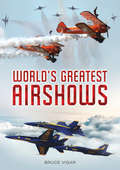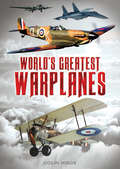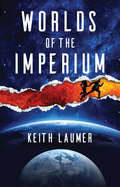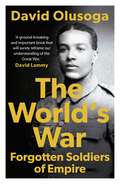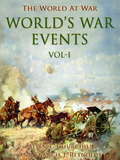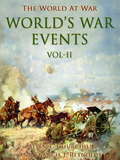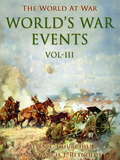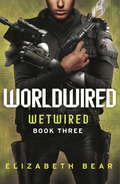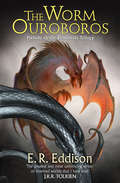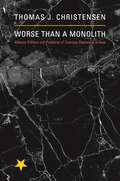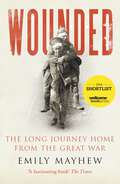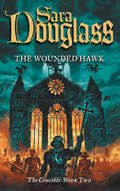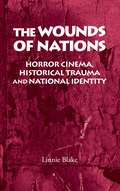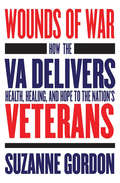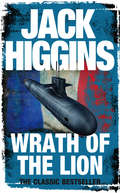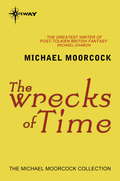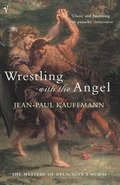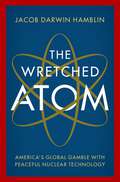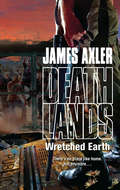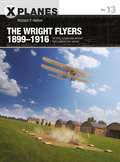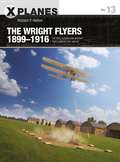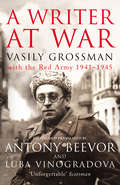- Table View
- List View
World's Greatest Airshows
by Bruce VigarAir shows are one of the world’s most popular, non - sporting outdoor attractions. Although the story of flight is over 100 years old, aircraft still hold a fascination for young and old, men and women from all backgrounds. Indeed, the first air show was held when aircraft and aviation was still in its infancy in the 1900s. Since then aviation has progressed in the full glare of the public gaze.Some air shows are held as a business venture or as a trade event where aircraft, avionics and other services are promoted to potential customers. Many air shows are held in support of local, national or military charities. Military air services often organise air shows at military airfields as a public relations exercise to thank the local community, promote military careers and raise the profile of the military. In this book, we cover the different types of air show and more importantly, the displays that make air shows memorable. For some it is the noise and speed of the latest military jets, for others, extraordinary aerobatics that seem to defy the laws of physics. There are also the displays of classic aircraft and warbirds as well as dramatic reconstructions of how aircraft are deployed. What is clear is how far aviation has come but questions persist in how much farther it can go?
World's Greatest Warplanes
by Colin HiggsThe World’s Greatest Warplanes are the ones that get the job done. Visionary engineers and inventors have created some of the most impressive fighting machines. RJ Mitchell’s Spitfire and Sydney Camm’s Hurricane fought for control of the skies against Kurt Tank’s FW190 and Willy Messerschmitt’s Bf 109. Roy Chadwick’s Lancaster and Boeing’s mighty B-17 Flying Fortress battled to take the attack to the enemy in dangerous skies. In the Cold War great names such as the RAF’s Lightning and Vulcan, the US Air Force’s Sabre and Phantom were up against the best from Mikoyan and Gurevich’s Mig factory. And in the last decades the skies have been dominated by the powerhouse American aviation industry. The F-16 is the defender of choice for the West and the amazing B-52 Stratofortress and B2 Spirit stealth bomber provide awesome offensive capability.In this ebook you will discover all these great military aircraft and many more, aircraft that have dominated the skies for more than a century.
Worlds of the Imperium
by Keith LaumerAmerican diplomat Brion Bayard is on assignment in Stockholm when he notices he's being shadowed. Before he can escape, Bayard is kidnapped and transported to a parallel universe: the Imperium, where history has taken a different turn and the British Empire and its allies rule the world. Yet another parallel world exists, and the Imperium has a task there for their reluctant visitor: the impersonation and assassination of a global dictator who happens to be Bayard's otherworldly double.This adventurous, action-packed novel is the work of award-winning author Keith Laumer, creator of the Bolo and Reteif stories. Science-fiction enthusiasts, especially those who enjoy alternate histories, will savor the twists and turns of this imaginative thriller.
The World's War: Forgotten Soldiers of Empire
by David Olusoga'A groundbreaking and important book that will surely reframe our understanding of the Great War' David Lammy'A genuinely groundbreaking piece of research' BBC History'Meticulously researched and beautifully written' Military History MonthlyIn a sweeping narrative, David Olusoga describes how Europe's Great War became the World's War – a multi-racial, multi-national struggle, fought in Africa and Asia as well as in Europe, which pulled in men and resources from across the globe.Throughout, he exposes the complex, shocking paraphernalia of the era's racial obsessions, which dictated which men would serve, how they would serve, and to what degree they would suffer. As vivid and moving as it is revelatory and authoritative, The World's War explores the experiences and sacrifices of four million non-European, non-white people whose stories have remained too long in the shadows.
World's War Events, Vol. I (The World At War)
by Francis ReynoldsA three volume series of books describing events of the WW I. This is part one.
World's War Events, Vol. II (The World At War)
by Francis ReynoldsA three volume series of books describing events of the WW I. This is part two.
World's War Events, Vol. III (The World At War)
by Francis ReynoldsA three volume series of books describing events of the WW I. This is part three.
Worldwired: Book Three (Jenny Casey #3)
by Elizabeth BearGive Canada's Master Warrant Officer Jenny Casey an inch and she'll take a galaxy. That's just the kind of person a world on the brink of destruction needs. The year is 2063, and Earth has been brutalized. An asteroid flung at Toronto by the PanChinese government has killed tens of millions and left the equivalent of a nuclear explosion in its wake. Humanity must find another option . . .Perched above the devastation in the starship Montreal, Jenny is still in the thick of the fray. Plugged into the worldwire, connected to a brilliant AI, her mind can be everywhere and anywhere at once. But it's focused on the mysterious alien beings right outside her ship. Are they there to help - or destroy? With Earth a breeding ground for treason and betrayal as governments struggle to assign blame, Jenny holds the fate of humankind in her artificially reconstructed hand . . .
The Worm Ouroboros: The Prelude To Zimiamvia (Barnes And Noble Library Of Essential Reading Ser.)
by E. R. EddisonThe lost classic masterpiece of magical realms, admired by Tolkien and the great prototype for The Lord of the Rings and modern fantasy fiction.
Worse Than a Monolith: Alliance Politics and Problems of Coercive Diplomacy in Asia
by Thomas J. ChristensenIn brute-force struggles for survival, such as the two World Wars, disorganization and divisions within an enemy alliance are to one's own advantage. However, most international security politics involve coercive diplomacy and negotiations short of all-out war. Worse Than a Monolith demonstrates that when states are engaged in coercive diplomacy--combining threats and assurances to influence the behavior of real or potential adversaries--divisions, rivalries, and lack of coordination within the opposing camp often make it more difficult to prevent the onset of conflict, to prevent existing conflicts from escalating, and to negotiate the end to those conflicts promptly. Focusing on relations between the Communist and anti-Communist alliances in Asia during the Cold War, Thomas Christensen explores how internal divisions and lack of cohesion in the two alliances complicated and undercut coercive diplomacy by sending confusing signals about strength, resolve, and intent. In the case of the Communist camp, internal mistrust and rivalries catalyzed the movement's aggressiveness in ways that we would not have expected from a more cohesive movement under Moscow's clear control. Reviewing newly available archival material, Christensen examines the instability in relations across the Asian Cold War divide, and sheds new light on the Korean and Vietnam wars. While recognizing clear differences between the Cold War and post-Cold War environments, he investigates how efforts to adjust burden-sharing roles among the United States and its Asian security partners have complicated U.S.-China security relations since the collapse of the Soviet Union.
Worse Than a Monolith: Alliance Politics and Problems of Coercive Diplomacy in Asia
by Thomas J. ChristensenIn brute-force struggles for survival, such as the two World Wars, disorganization and divisions within an enemy alliance are to one's own advantage. However, most international security politics involve coercive diplomacy and negotiations short of all-out war. Worse Than a Monolith demonstrates that when states are engaged in coercive diplomacy--combining threats and assurances to influence the behavior of real or potential adversaries--divisions, rivalries, and lack of coordination within the opposing camp often make it more difficult to prevent the onset of conflict, to prevent existing conflicts from escalating, and to negotiate the end to those conflicts promptly. Focusing on relations between the Communist and anti-Communist alliances in Asia during the Cold War, Thomas Christensen explores how internal divisions and lack of cohesion in the two alliances complicated and undercut coercive diplomacy by sending confusing signals about strength, resolve, and intent. In the case of the Communist camp, internal mistrust and rivalries catalyzed the movement's aggressiveness in ways that we would not have expected from a more cohesive movement under Moscow's clear control. Reviewing newly available archival material, Christensen examines the instability in relations across the Asian Cold War divide, and sheds new light on the Korean and Vietnam wars. While recognizing clear differences between the Cold War and post-Cold War environments, he investigates how efforts to adjust burden-sharing roles among the United States and its Asian security partners have complicated U.S.-China security relations since the collapse of the Soviet Union.
Wounded: From Battlefield to Blighty, 1914-1918
by Emily MayhewThis is the unforgettable story of the remarkable medical workers of World War One.A hundred years ago, the Armistice that ended the Great War was signed. The human cost was devastating: over 21 million military wounded, and nearly 10 million killed. The injuries on the battlefield were unlike anything those in the medical field had ever witnessed. Yet, they adapted incredibly fast – saving millions of lives. Drawing on letters and diary entries, we follow the lone stretcher bearer into the trenches only to find that they were all dead, to the dugouts where rescue teams dug frantically to escape the earth-shaking shellfire, and from stretcher to aid station, from jolting ambulance to crowded operating tent, exploring actual cases of casualties who recorded their terrifying and remarkable experiences. A groundbreaking book of the history of the Western Front from a new perspective, this is a tribute to the indispensable medical network that came together and saved our soldiers.‘A highly readable account...this is an engaging book...they are voices that deserve to be heard.’ Daily Express
The Wounded Hawk: Book Two Of The Crucible Trilogy (The Crucible Trilogy #2)
by Sara DouglassThe second book of The Crucible, an exciting historical fantasy from the author of the popular Axis Triology.
The wounds of nations: Horror cinema, historical trauma and national identity (PDF)
by Linnie BlakeThe wounds of nations: Horror cinema, historical trauma and national identity explores the ways in which the unashamedly disturbing conventions of international horror cinema allow audiences to engage with the traumatic legacy of the recent past in a manner that has serious implications for the ways in which we conceive of ourselves both as gendered individuals and as members of a particular nation-state. Exploring a wide range of stylistically distinctive and generically diverse film texts, its analysis ranges from the body horror of the American 1970s to the avant-garde proclivities of German Reunification horror, from the vengeful supernaturalism of recent Japanese chillers and their American remakes to the post-Thatcherite masculinity horror of the UK and the resurgence of 'hillbilly' horror in the period following September 11th 2001. In each case, it is argued, horror cinema forces us to look again at the wounds inflicted on individuals, families, communities and nations by traumatic events such as genocide and war, terrorist outrage and seismic political change, wounds that are all too often concealed beneath ideologically expedient discourses of national cohesion. By proffering a radical critique of the nation-state and the ideologies of identity it promulgates, horror cinema is seen to offer us a disturbing, yet perversely life affirming, means of working through the traumatic legacy of recent times.
The wounds of nations: Horror cinema, historical trauma and national identity
by Linnie BlakeThe wounds of nations: Horror cinema, historical trauma and national identity explores the ways in which the unashamedly disturbing conventions of international horror cinema allow audiences to engage with the traumatic legacy of the recent past in a manner that has serious implications for the ways in which we conceive of ourselves both as gendered individuals and as members of a particular nation-state. Exploring a wide range of stylistically distinctive and generically diverse film texts, its analysis ranges from the body horror of the American 1970s to the avant-garde proclivities of German Reunification horror, from the vengeful supernaturalism of recent Japanese chillers and their American remakes to the post-Thatcherite masculinity horror of the UK and the resurgence of 'hillbilly' horror in the period following September 11th 2001. In each case, it is argued, horror cinema forces us to look again at the wounds inflicted on individuals, families, communities and nations by traumatic events such as genocide and war, terrorist outrage and seismic political change, wounds that are all too often concealed beneath ideologically expedient discourses of national cohesion. By proffering a radical critique of the nation-state and the ideologies of identity it promulgates, horror cinema is seen to offer us a disturbing, yet perversely life affirming, means of working through the traumatic legacy of recent times.
Wounds of War: How the VA Delivers Health, Healing, and Hope to the Nation's Veterans (The Culture and Politics of Health Care Work)
by Suzanne GordonU.S. military conflicts abroad have left nine million Americans dependent on the Veterans Health Administration (VHA) for medical care. Their "wounds of war" are treated by the largest hospital system in the country—one that has come under fire from critics in the White House, on Capitol Hill, and in the nation's media.In Wounds of War, Suzanne Gordon draws on five years of observational research to describe how the VHA does a better job than private sector institutions offering primary and geriatric care, mental health and home care services, and support for patients nearing the end of life. In the unusual culture of solidarity between patients and providers that the VHA has fostered, Gordon finds a working model for higher-quality health care and a much-needed alternative to the practice of for-profit medicine.
The Wrecks of Time
by Michael MoorcockEarth zero to Earth fifteen - which was the real one?What the inhabitants of Greater America didn't realize was that theirs was the only inhabited landmass, apart from one island in the Philippines. They still talked about foreign countries, though they would forget little by little, but the countries were only in their imaginations, mysterious and romantic places where nobody actually went..That was the way it was on E-3, one of the fifteen alternate Earths that had been discovered through the subspace experiments.Professor Faustaff knew that these alternate earths were somehow recent creations, and that they were under attack from the strange eroding raids of the mysterious bands known as the D-Squads. But there were tens of millions of people on those Earths who were entitled to life and protection-and unless Faustaff and his men could crack the mystery of these worlds' creation and the more urgent problem of their impending destruction, it would mean not only the end of these parallel planets, but just possibly the blanking out of all civilization in the universe.
Wrestling With The Angel: The Mystery Of Delacroix's Mural
by Jean-Paul KauffmannNear the end of his life, the great Romantic artist Eug-ne Delacroix (1798-1863) painted one of the most enigmatic episodes from the Bible: Jacob wrestling with the angel. This painting, which decorates the wall of the Chapel of the Holy Angels in the Paris church of Saint-Sulpice, is Delacroix's "spiritual testament". But Sain-Sulpice is a mysterious church where everything happens behind the scenes. A fan of Inspector Maigret, Jean-Paul Kauffmann investigates the painting and the church, paying particular attention to its hidden history. He searches for clues in a bar in Dieppe, a castle in Quercy, a village in the Argonne, an oak tree in the forest at S-nart, even a golf course in the Loiret. The trail leads him to an art critic, a lecturer at the Louvre, and a sculptor who has a studio in the attic of Saint-Sulpice itself. All these intertwining threads finally come together in a central motif in which Kauffmann himself is involved. There comes a time in which everyone must wrestle with the angel.
The Wretched Atom: America's Global Gamble with Peaceful Nuclear Technology
by Jacob Darwin HamblinA groundbreaking narrative of how the United States offered the promise of nuclear technology to the developing world and its gamble that other nations would use it for peaceful purposes. After the Second World War, the United States offered a new kind of atom that differed from the bombs that destroyed Hiroshima and Nagasaki. This atom would cure diseases, produce new foods, make deserts bloom, and provide abundant energy for all. It was an atom destined for the formerly colonized, recently occupied, and mostly non-white parts of the world that were dubbed the "wretched of the earth" by Frantz Fanon. The "peaceful atom" had so much propaganda potential that President Dwight Eisenhower used it to distract the world from his plan to test even bigger thermonuclear weapons. His scientists said the peaceful atom would quicken the pulse of nature, speeding nations along the path of economic development and helping them to escape the clutches of disease, famine, and energy shortfalls. That promise became one of the most misunderstood political weapons of the twentieth century. It was adopted by every subsequent US president to exert leverage over other nations' weapons programs, to corner world markets of uranium and thorium, and to secure petroleum supplies. Other countries embraced it, building reactors and training experts. Atomic promises were embedded in Japan's postwar recovery, Ghana's pan-Africanism, Israel's quest for survival, Pakistan's brinksmanship with India, and Iran's pursuit of nuclear independence. As The Wretched Atom shows, promoting civilian atomic energy was an immense gamble, and it was never truly peaceful. American promises ended up exporting violence and peace in equal measure. While the United States promised peace and plenty, it planted the seeds of dependency and set in motion the creation of today's expanded nuclear club.
The Wretched Atom: America's Global Gamble with Peaceful Nuclear Technology
by Jacob Darwin HamblinA groundbreaking narrative of how the United States offered the promise of nuclear technology to the developing world and its gamble that other nations would use it for peaceful purposes. After the Second World War, the United States offered a new kind of atom that differed from the bombs that destroyed Hiroshima and Nagasaki. This atom would cure diseases, produce new foods, make deserts bloom, and provide abundant energy for all. It was an atom destined for the formerly colonized, recently occupied, and mostly non-white parts of the world that were dubbed the "wretched of the earth" by Frantz Fanon. The "peaceful atom" had so much propaganda potential that President Dwight Eisenhower used it to distract the world from his plan to test even bigger thermonuclear weapons. His scientists said the peaceful atom would quicken the pulse of nature, speeding nations along the path of economic development and helping them to escape the clutches of disease, famine, and energy shortfalls. That promise became one of the most misunderstood political weapons of the twentieth century. It was adopted by every subsequent US president to exert leverage over other nations' weapons programs, to corner world markets of uranium and thorium, and to secure petroleum supplies. Other countries embraced it, building reactors and training experts. Atomic promises were embedded in Japan's postwar recovery, Ghana's pan-Africanism, Israel's quest for survival, Pakistan's brinksmanship with India, and Iran's pursuit of nuclear independence. As The Wretched Atom shows, promoting civilian atomic energy was an immense gamble, and it was never truly peaceful. American promises ended up exporting violence and peace in equal measure. While the United States promised peace and plenty, it planted the seeds of dependency and set in motion the creation of today's expanded nuclear club.
Wretched Earth
by James AxlerAfter the Mega cull, the weak died off, so that a century later, the living have descended from only the toughest stock. Still, it takes more than strength to survive Deathlands.
The Wright Flyers 1899–1916: The kites, gliders, and aircraft that launched the “Air Age” (X-Planes)
by Richard P. HallionOrville and Wilbur Wright, two bicycle-making brothers from Dayton, Ohio, secured their place as the most famous names in aviation history when, on December 17, 1903, they made the first powered, controlled, and sustained heavier-than-air flight. But their success over the cold and windswept Carolina dunes that day has overshadowed their many other accomplishments before and after that historic flight. The Wrights' progression from theory to analysis to ground-testing components and wing shapes, and then to flight-testing kites, gliders, and their first powered aeroplane, marked the world's first successful 'X-Plane' research and development programme. They established a template all subsequent aircraft have followed, one still relevant in the era of hypersonic flight and drone research.This book traces the Wright Brothers' story, from their first success on that cold December day throughout their glory years to their eventual eclipse by other aviators. It explores in detail the process that lead them to their pioneering craft and their many subsequent achievements over the following years, and highlights their enduring importance in the age of modern flight.
The Wright Flyers 1899–1916: The kites, gliders, and aircraft that launched the “Air Age” (X-Planes #13)
by Richard P. HallionOrville and Wilbur Wright, two bicycle-making brothers from Dayton, Ohio, secured their place as the most famous names in aviation history when, on December 17, 1903, they made the first powered, controlled, and sustained heavier-than-air flight. But their success over the cold and windswept Carolina dunes that day has overshadowed their many other accomplishments before and after that historic flight. The Wrights' progression from theory to analysis to ground-testing components and wing shapes, and then to flight-testing kites, gliders, and their first powered aeroplane, marked the world's first successful 'X-Plane' research and development programme. They established a template all subsequent aircraft have followed, one still relevant in the era of hypersonic flight and drone research.This book traces the Wright Brothers' story, from their first success on that cold December day throughout their glory years to their eventual eclipse by other aviators. It explores in detail the process that lead them to their pioneering craft and their many subsequent achievements over the following years, and highlights their enduring importance in the age of modern flight.
A Writer At War: Vasily Grossman with the Red Army 1941-1945
by Vasily Grossman Antony Beevor Luba VinogradovaIn the summer of 1941 as the Germans invade Russia, Soviet Army’s newspaper reporter Vasily Grossman is swept up into the frontlines of war and witnesses some of the most savage atrocities in Russian history.As Grossman follows the Red Army from the defense of Moscow, to the carnage at Stalingrad, to the Nazi genocide in Treblinka, his writings paint a vividly raw and devastating account of Operation Barbarossa during World War Two. Grossman’s notebooks, war diaries, personal correspondence and newspaper articles are meticulously woven into a gripping narrative and provide a piercing look into the life of the author behind Life and Fate - dubbed the twentieth century War and Peace. A Writer at War stands as an unforgettable eyewitness account of the Eastern Front and places Grossman as the leading Soviet voice of ‘the ruthless truth of war’.‘A remarkable addition to the literature of 1941-45...a wonderful portrait of the wartime experience of Russia... A worthy memorial to a remarkable man’ Sunday Telegraph
